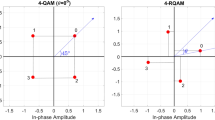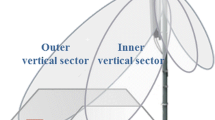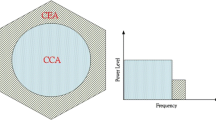Abstract
Conventional trisectored cellular systems have not taken full advantages of antenna directivities to enhance frequency reuse efficiency. A novel Channel Alternation and Rotation (CAR) scheme is proposed to coordinate channel assignments with antenna directivities. CAR employs a multi-interval cell-reuse layout. Each cell type is allocated extra channel set(s) to provide network designers the flexibility to assign channels avoiding nearest front lobe interference to enhance the carrier to interference ratio (C/I). CAR allows deployment of smaller and non-integer reuse factors based on C/I requirements, thus increasing channel capacity. Since current base station equipment is utilized, no additional costs are introduced.
Similar content being viewed by others
References
G.K. Chan, Effects of sectorization on the spectrum efficiency of cellular radio systems, IEEE Transactions on Vehicular Technology 41 (1992) 217–225.
S. Faruque, Cellular Mobile Systems Engineering (Artech House, Boston, 1997).
S.W. Halpern, Reuse partitioning in cellular systems, in: IEEE Vehicular Technology Conference, 1983, pp. 332-327.
I. Katzela and M. Naghshineh, Channel assignment schemes for cellular mobile telecommunication systems: a comprehensive survey, IEEE Personal Communications 3(3) (1996) 10–31.
Y. Kinoshita and D. Asano, Enhanced conceptual design formulae for frequency channel double reuse digital systems using sectored cells, in: IEEE Vehicular Technology Conference, Vol. 1, 1998, pp. 679–682.
X. Larange, Multitier Cell Design, IEEE Communication Magazine (1997) 60-65.
W.C. Lee, Smaller cells for greater performance: A new microcell architecture that reduces interference, increases system capacity, improves voice quality, and demands fewer handoffs is ideally suited for PCS systems, IEEE Communication Magazine (1991) 19-23.
V.A. Nguyen, P.J. Wan and O. Frieder, Channel alternation and rotation for tri-sectored directional antenna cellular systems, in: IEEE Vehicular Technology Conference 54, Vol. 1, 2001, pp. 394–398.
V.A. Nguyen, P.J. Wan, and O. Frieder, Channel alternation and rotation in narrow beam trisector cellular systems, in: Proc. of European Wireless, Vol. 2, 2002, pp. 739–745.
T.S. Rappaport, Wireless Communication: Principles and Practice (Prentice-Hall, Englewood Cliffs, NJ, 2002).
P.S. Rha, Frequency reuse scheme with reduced co-channel interference for fixed cellular systems, IEE Electronics Letters 34(3) (1998) 237–238.
R. Steele, C.-C. Lee and P. Gould, GSM, cdmaOne and 3G Systems (Wiley, New York, 2001).
H. Tawfik, Frequency planning considerations for digital cellular systems, in: IEEE Vehicular Technology Conference 40, 1990, pp. 200–206.
L.-C. Wang, A new cellular architecture based on an interleaved cluster concept, IEEE Transactions on Vehicular Technology 48(6) (1999) 1809–1818.
L.-C.Wang, C.K. Chawla and L.J. Greenstein, Performance studies of narrow-beam trisector cellular systems, in: IEEE Vehicular Technology Conference, Vol. 2, 1998, pp. 724–730.
L.-C. Wang and K.K. Leung, Performance enhancement in narrow-beam quad-sector cell and interleaved channel assignment in wireless networks, in: Global Telecommunications Conference, 1999, pp. 2719-2724.
J. Xiang, A novel two site frequency reuse plan, in: IEEE Vehicular Technology Conference, 1996, pp. 44-445.
Author information
Authors and Affiliations
Corresponding author
Rights and permissions
About this article
Cite this article
Nguyen, V.A., Wan, PJ. & Frieder, O. Channel Alternation and Rotation for Trisectorized Cellular Systems. Telecommunication Systems 22, 77–94 (2003). https://doi.org/10.1023/A:1023430602079
Issue Date:
DOI: https://doi.org/10.1023/A:1023430602079




